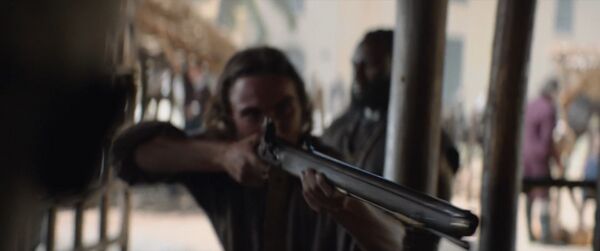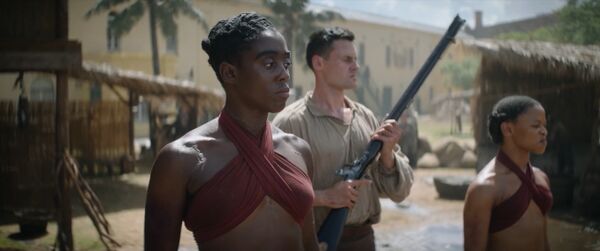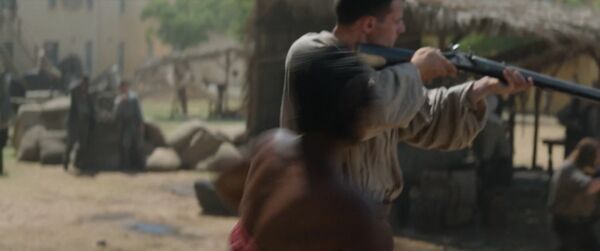The Woman King is a 2022 historical fiction action film directed by Gina Prince-Bythewood. Set in 1823, the film stars Viola Davis as General Nanisca, head of the Agojie, an all-female warrior group of the West African kingdom of Dahomey. Upon release, the film was widely criticized for depicting Dahomey as an anti-slavery force, when in reality it was a major player in the West African slave trade, selling enslaved Africans to the Americas into the 1860s.
The following weapons were used in the film The Woman King:
 WARNING! THIS PAGE CONTAINS SPOILERS!
WARNING! THIS PAGE CONTAINS SPOILERS!
Flintlock Pistol
Numeeous characters, including General Oba Ade (Jimmy Odukoya), Malik (Jordan Bolger), Santo Ferreira (Hero Fiennes Tiffin), and Nawi (Thuso Mbedu) use Flintlock Pistols throughout the movie.

British Heavy Dragoon Pistol - .62 caliber

General Oba Ade and his second-in-command (uncredited), both carry flintlock pistols.

Malik with a holstered pistol.

Malik and Santo Ferreira both have flintlock pistols.

The pistol is seen on the belt of a dead Portuguese slaver.

Santo Ferreira pulls his flintlock pistol at the slaves.

Nawi aims her pistol after firing it.
Charleville Musket
The Charleville Musket is the standard long firearm of Dahomey soldiers, including the Agojie (Dahomey Amazons). While their armament was not standardized (and French muskets were sometimes sold in Africa), long barreled Danish muskets (alongside French and English copies of those) would have been the most common firearms in Dahomey.

Mousquet Charleville Modèle 1766 - .69 caliber

Agojie (including Nawi (Thuso Mbedu), Izogie (
Lashana Lynch), Esi (Shaina West), Amenza (Sheila Atim), and Ode (
Adrienne Warren) fire their muskets during training.

Agojie hold their muskets after firing.

Dahomey soldiers raise their muskets...

...and fire a salute to Oyo General Oba Ade.

Numerous Charleville muskets and one matchlock musket is seen on the ground.

Dahomey soldiers hold their muskets.

A Dahomey soldier raises his musket...

...and fires it to signal the start of the military exam.

Dahomey soldiers armed with muskets attack Oyo soldiers.

Dahomey soldiers fire their muskets at Oyo soldiers.

Izogie fire her musket at Oyo soldiers.

A Portuguese soldier aims the musket.

The Dahomey army brandish their muskets while celebrating victory over the Oyo Empire.
Brown Bess Flintlock Musket
Oyo Empire soldiers are armed with the Brown Bess Flintlock Musket. Several Portuguese soldiers and slavers also use Brown Bess Flintlock Muskets; the Brown Bess was the standard firearm of Portuguese troops from the Napoleonic Wars to the 1850s.

Modern reproduction "Long Land Pattern" Brown Bess Infantry musket made from 1722-1768 - .75 caliber

Oyo soldiers hold their muskets.

Oyo soldiers run, armed with the Brown Bess and Kabyle muskets.

Oyo soldiers fire their muskets.

Oyo soldiers guard the salves, which the Oyo trade to Portuguese slavers.

Two Portuguese slavers hold their muskets.

Oyo soldiers fire their muskets at Dahomey soldiers.

Oyo soldiers with the muskets while realizing they are losing the battle against the Dahomey army.

Oyo soldiers carry slung muskets.

A Portuguese slaver holds his musket.

An Oyo soldier with the musket in the background.
Matchlock Musket
A Matchlock Musket is briefly seen at one point.

European Matchlock musket.

Numerous Charleville muskets and one matchlock musket is seen on the ground.

Ade's second-in-command (uncredited) examines the musket.
Kabyle Musket
Numerous North African Kabyle Muskets appear in several scenes.

Moukhala with snaphance lock, Džeferdar with miquelet lock, two moukhala converted to percussion lock.

Oyo soldiers run armed with the Brown Bess and Kabyle muskets.

Oyo soldiers fire their muskets.

An Oyo soldier holds his musket during the battle.

Amenza (Sheila Atim) grabs the musket from an Oyo soldier and uses it to shoot another Oyo soldier, armed with a Kabyle musket as well.

Amenza crushes the skull of one more Oyo soldier with the stock.

An Oyo soldier holds the musket in the background right.
Baker Rifle
Numerous Portuguese slavers carry a Baker Rifle. Santo Ferreira (Hero Fiennes Tiffin) holds a Baker Rifle in a promo shot, but not in the actual film. Around 2,000 rifles were issued to Portuguese light infantry during the Napoleonic Wars, some of those weapons later saw service in Brazil (although it is unclear how many, if any, reached Africa).

Baker Rifle (1800 - 1838) - 0.625 inch (15.9 mm)

The rifle's muzzle is seen.

A Portuguese slaver holds his rifle.

Numerous African slavers with slung rifles.

A Portuguese slaver aims his rifle.

Another view of the same scene.

A Portuguese slaver holds his rifle.

Another view of the same scene.

A slaver aims the shotgun. Two other slavers aim Baker Rifles.

Izogie captures the rifle from this slaver.

Nawi attacks another slaver, who holds a similar rifle.

Izogie runs, captured rifle in hands.

A Portuguese slaver tries to fire his rifle at Agojie.

Santo Ferreira with the Baker Rifle in a promo shot.
Blunderbuss (Possibly Mocked-up)
At least two slavers are armed with a Blunderbuss. One of these guns is possibly a mock-up.

A slaver aims his blunderbuss. Note that this gun has a rather small muzzle, and possibly fake flaring, so it may be a mock-up.

The same character aims his blunderbuss a second later.

Slaver runs, blunderbuss in hands.

Ditto. Once again, note the small barrel.

Slaver at the left holds the blunderbuss, while the salver at the right holds a double barreled flintlock fowler.
Flintlock Fowler
A double barreled Flintlock Fowler is briefly seen in the hands of slaver. One of the Agojie holds the similar looking gun (most likely, the same movie prop).

Double Barreled Flintlock Shotgun - 20 gauge

A slaver aims the shotgun. Two other slavers aim Baker Rifles.

The slaver at the left holds the blunderbuss, while the slaver at the right holds the double barreled flintlock fowler.

An Agojie holds the gun, taken from a slaver.
Musket Relief
Two rather generic muskets are seen as part of the sculpted reliefs on the gate of the Royal Palace.

The reliefs on the gate with two depictions of muskets.
![]() WARNING! THIS PAGE CONTAINS SPOILERS!
WARNING! THIS PAGE CONTAINS SPOILERS!

































































